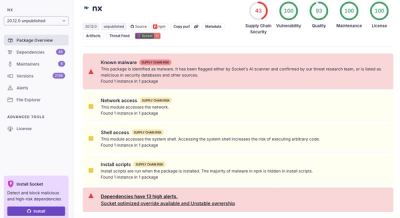
Security News
Nx npm Packages Compromised in Supply Chain Attack Weaponizing AI CLI Tools
Malicious Nx npm versions stole secrets and wallet info using AI CLI tools; Socket’s AI scanner detected the supply chain attack and flagged the malware.
This gem provides access to the Atlassian JIRA REST API.
This sample usage demonstrates how you can interact with JIRA's API using the jira-ruby gem.
Before running, install the jira-ruby gem:
gem install jira-ruby
Connect to JIRA Firstly, establish a connection with your JIRA instance by providing a few configuration parameters: There are other ways to connect to JIRA listed below | Personal Access Token
options = {
:private_key_file => "rsakey.pem",
:context_path => '',
:consumer_key => 'your_consumer_key',
:site => 'your_jira_instance_url'
}
client = JIRA::Client.new(options)
After establishing the connection, you can fetch all projects and display their key and name:
projects = client.Project.all
projects.each do |project|
puts "Project -> key: #{project.key}, name: #{project.name}"
end
The jira-ruby gem allows you to refer to fields by their custom names rather than identifiers. Make sure to map fields before using them:
client.Field.map_fields
old_way = issue.customfield_12345
# Note: The methods mapped here adopt a unique style combining PascalCase and snake_case conventions.
new_way = issue.Special_Field
To find issues based on specific criteria, you can use JIRA Query Language (JQL):
client.Issue.jql(a_normal_jql_search, fields:[:description, :summary, :Special_field, :created])
issue = client.Issue.build
labels = ['label1', 'label2']
issue.save({
"fields" => {
"summary" => "blarg from in example.rb",
"project" => {"key" => "SAMPLEPROJECT"},
"issuetype" => {"id" => "3"},
"labels" => labels,
"priority" => {"id" => "1"}
}
})
issue = client.Issue.find("10002")
issue.save({"fields"=>{"summary"=>"EVEN MOOOOOOARRR NINJAAAA!"}})
issue_transition = issue.transitions.build
issue_transition.save!('transition' => {'id' => transition_id})
issue = client.Issue.find('SAMPLEPROJECT-2')
issue.delete
Apart from the operations listed above, this API wrapper supports several other capabilities like: • Searching for a user • Retrieving an issue's watchers • Changing the assignee of an issue • Adding attachments and comments to issues • Managing issue links and much more.
Not all examples are shown in this README; refer to the complete script example for a full overview of the capabilities supported by this API wrapper.
Before running tests, you will need a public certificate generated.
rake jira:generate_public_cert
On Mac OS,
./bin/atlas-run-standalone --product jira
Once this is running, you should be able to connect to
http://localhost:2990/ and login to the JIRA admin system using admin:admin
You'll need to create a dummy project and probably some issues to test using this library.
From the JIRA API tutorial
The first step is to register a new consumer in JIRA. This is done through the Application Links administration screens in JIRA. Create a new Application Link. Administration/Plugins/Application Links
When creating the Application Link use a placeholder URL or the correct URL to your client (e.g.
http://localhost:3000), if your client can be reached via HTTP and choose the Generic Application type. After this Application Link has been created, edit the configuration and go to the incoming authentication configuration screen and select OAuth. Enter in this the public key and the consumer key which your client will use when making requests to JIRA.
This public key and consumer key will need to be generated by the Gem user, using OpenSSL or similar to generate the public key and the provided rake task to generate the consumer key.
After you have entered all the information click OK and ensure OAuth authentication is enabled.
For two legged oauth in server mode only, not in cloud based JIRA, make sure to Allow 2-Legged OAuth
Follow the same steps described above to set up a new Application Link in JIRA, however there is no need to set up any "incoming authentication" as this defaults to HTTP Basic Auth.
Jira supports cookie based authentication whereby user credentials are passed to JIRA via a JIRA REST API call. This call returns a session cookie which must then be sent to all following JIRA REST API calls.
To enable cookie based authentication, set :auth_type to :cookie,
set :use_cookies to true and set :username and :password accordingly.
require 'jira-ruby'
options = {
:username => 'username',
:password => 'pass1234',
:site => 'http://mydomain.atlassian.net:443/',
:context_path => '',
:auth_type => :cookie, # Set cookie based authentication
:use_cookies => true, # Send cookies with each request
:additional_cookies => ['AUTH=vV7uzixt0SScJKg7'] # Optional cookies to send
# with each request
}
client = JIRA::Client.new(options)
project = client.Project.find('SAMPLEPROJECT')
project.issues.each do |issue|
puts "#{issue.id} - #{issue.summary}"
end
Some authentication schemes might require additional cookies to be sent with
each request. Cookies added to the :additional_cookies option will be added
to each request. This option should be an array of strings representing each
cookie to add to the request.
Some authentication schemes that require additional cookies ignore the username
and password sent in the JIRA REST API call. For those use cases, :username
and :password may be omitted from options.
If your JIRA system is configured to support Personal Access Token authorization, minor modifications are needed in how credentials are communicated to the server. Specifically, the paremeters :username and :password are not needed. Also, the parameter :default_headers is needed to contain the api_token, which can be obtained following the official documentation from Atlassian. Please note that the Personal Access Token can only be used as it is. If it is encoded (with base64 or any other encoding method) then the token will not work correctly and authentication will fail.
require 'jira-ruby'
# NOTE: the token should not be encoded
api_token = API_TOKEN_OBTAINED_FROM_JIRA_UI
options = {
:site => 'http://mydomain.atlassian.net:443/',
:context_path => '',
:default_headers => { 'Authorization' => "Bearer #{api_token}" },
:auth_type => :basic
}
client = JIRA::Client.new(options)
project = client.Project.find('SAMPLEPROJECT')
project.issues.each do |issue|
puts "#{issue.id} - #{issue.summary}"
end
Using HTTP Basic Authentication, configure and connect a client to your instance of JIRA.
Note: If your Jira install is hosted on atlassian.net, it will have no context path by default. If you're having issues connecting, try setting context_path to an empty string in the options hash.
require 'rubygems'
require 'pp'
require 'jira-ruby'
# Consider the use of :use_ssl and :ssl_verify_mode options if running locally
# for tests.
# NOTE basic auth no longer works with Jira, you must generate an API token, to do so you must have jira instance access rights. You can generate a token here: https://id.atlassian.com/manage/api-tokens
# You will see JIRA::HTTPError (JIRA::HTTPError) if you attempt to use basic auth with your user's password
username = "myremoteuser"
api_token = "myApiToken"
options = {
:username => username,
:password => api_token,
:site => 'http://localhost:8080/', # or 'https://<your_subdomain>.atlassian.net/'
:context_path => '/myjira', # often blank
:auth_type => :basic,
:read_timeout => 120
}
client = JIRA::Client.new(options)
# Show all projects
projects = client.Project.all
projects.each do |project|
puts "Project -> key: #{project.key}, name: #{project.name}"
end
Using oauth, the gem requires the consumer key and public certificate file (which are generated in their respective rake tasks) to initialize an access token for using the JIRA API.
Note that currently the rake task which generates the public certificate requires OpenSSL to be installed on the machine.
Below is an example for setting up a rails application for OAuth authorization.
Ensure the JIRA gem is loaded correctly
# Gemfile
...
gem 'jira-ruby', :require => 'jira-ruby'
...
Add common methods to your application controller and ensure access token errors are handled gracefully
# app/controllers/application_controller.rb
class ApplicationController < ActionController::Base
protect_from_forgery
rescue_from JIRA::OauthClient::UninitializedAccessTokenError do
redirect_to new_jira_session_url
end
private
def get_jira_client
# add any extra configuration options for your instance of JIRA,
# e.g. :use_ssl, :ssl_verify_mode, :context_path, :site
options = {
:private_key_file => "rsakey.pem",
:consumer_key => 'test'
}
@jira_client = JIRA::Client.new(options)
# Add AccessToken if authorised previously.
if session[:jira_auth]
@jira_client.set_access_token(
session[:jira_auth]['access_token'],
session[:jira_auth]['access_key']
)
end
end
end
Create a controller for handling the OAuth conversation.
# app/controllers/jira_sessions_controller.rb
class JiraSessionsController < ApplicationController
before_filter :get_jira_client
def new
callback_url = 'http://callback'
request_token = @jira_client.request_token(oauth_callback: callback_url)
session[:request_token] = request_token.token
session[:request_secret] = request_token.secret
redirect_to request_token.authorize_url
end
def authorize
request_token = @jira_client.set_request_token(
session[:request_token], session[:request_secret]
)
access_token = @jira_client.init_access_token(
:oauth_verifier => params[:oauth_verifier]
)
session[:jira_auth] = {
:access_token => access_token.token,
:access_key => access_token.secret
}
session.delete(:request_token)
session.delete(:request_secret)
redirect_to projects_path
end
def destroy
session.data.delete(:jira_auth)
end
end
Create your own controllers for the JIRA resources you wish to access.
# app/controllers/issues_controller.rb
class IssuesController < ApplicationController
before_filter :get_jira_client
def index
@issues = @jira_client.Issue.all
end
def show
@issue = @jira_client.Issue.find(params[:id])
end
end
Here's the same example as a Sinatra application:
require 'jira-ruby'
class App < Sinatra::Base
enable :sessions
# This section gets called before every request. Here, we set up the
# OAuth consumer details including the consumer key, private key,
# site uri, and the request token, access token, and authorize paths
before do
options = {
:site => 'http://localhost:2990/',
:context_path => '/jira',
:signature_method => 'RSA-SHA1',
:request_token_path => "/plugins/servlet/oauth/request-token",
:authorize_path => "/plugins/servlet/oauth/authorize",
:access_token_path => "/plugins/servlet/oauth/access-token",
:private_key_file => "rsakey.pem",
:rest_base_path => "/rest/api/2",
:consumer_key => "jira-ruby-example"
}
@jira_client = JIRA::Client.new(options)
@jira_client.consumer.http.set_debug_output($stderr)
# Add AccessToken if authorised previously.
if session[:jira_auth]
@jira_client.set_access_token(
session[:jira_auth][:access_token],
session[:jira_auth][:access_key]
)
end
end
# Starting point: http://<yourserver>/
# This will serve up a login link if you're not logged in. If you are, it'll show some user info and a
# signout link
get '/' do
if !session[:jira_auth]
# not logged in
<<-eos
<h1>jira-ruby (JIRA 5 Ruby Gem) demo </h1>You're not signed in. Why don't you
<a href=/signin>sign in</a> first.
eos
else
#logged in
@issues = @jira_client.Issue.all
# HTTP response inlined with bind data below...
<<-eos
You're now signed in. There #{@issues.count == 1 ? "is" : "are"} #{@issues.count}
issue#{@issues.count == 1 ? "" : "s"} in this JIRA instance. <a href='/signout'>Signout</a>
eos
end
end
# http://<yourserver>/signin
# Initiates the OAuth dance by first requesting a token then redirecting to
# http://<yourserver>/auth to get the @access_token
get '/signin' do
callback_url = "#{request.base_url}/callback"
request_token = @jira_client.request_token(oauth_callback: callback_url)
session[:request_token] = request_token.token
session[:request_secret] = request_token.secret
redirect request_token.authorize_url
end
# http://<yourserver>/callback
# Retrieves the @access_token then stores it inside a session cookie. In a real app,
# you'll want to persist the token in a datastore associated with the user.
get "/callback" do
request_token = @jira_client.set_request_token(
session[:request_token], session[:request_secret]
)
access_token = @jira_client.init_access_token(
:oauth_verifier => params[:oauth_verifier]
)
session[:jira_auth] = {
:access_token => access_token.token,
:access_key => access_token.secret
}
session.delete(:request_token)
session.delete(:request_secret)
redirect "/"
end
# http://<yourserver>/signout
# Expires the session
get "/signout" do
session.delete(:jira_auth)
redirect "/"
end
end
Here's an example on how to use 2 legged OAuth:
require 'rubygems'
require 'pp'
require 'jira-ruby'
options = {
:site => 'http://localhost:2990/',
:context_path => '/jira',
:signature_method => 'RSA-SHA1',
:private_key_file => "rsakey.pem",
:rest_base_path => "/rest/api/2",
:auth_type => :oauth_2legged,
:consumer_key => "jira-ruby-example"
}
client = JIRA::Client.new(options)
client.set_access_token("","")
# Show all projects
projects = client.Project.all
projects.each do |project|
puts "Project -> key: #{project.key}, name: #{project.name}"
end
FAQs
Unknown package
We found that jira-ruby demonstrated a healthy version release cadence and project activity because the last version was released less than a year ago. It has 2 open source maintainers collaborating on the project.
Did you know?

Socket for GitHub automatically highlights issues in each pull request and monitors the health of all your open source dependencies. Discover the contents of your packages and block harmful activity before you install or update your dependencies.

Security News
Malicious Nx npm versions stole secrets and wallet info using AI CLI tools; Socket’s AI scanner detected the supply chain attack and flagged the malware.

Security News
CISA’s 2025 draft SBOM guidance adds new fields like hashes, licenses, and tool metadata to make software inventories more actionable.

Security News
A clarification on our recent research investigating 60 malicious Ruby gems.